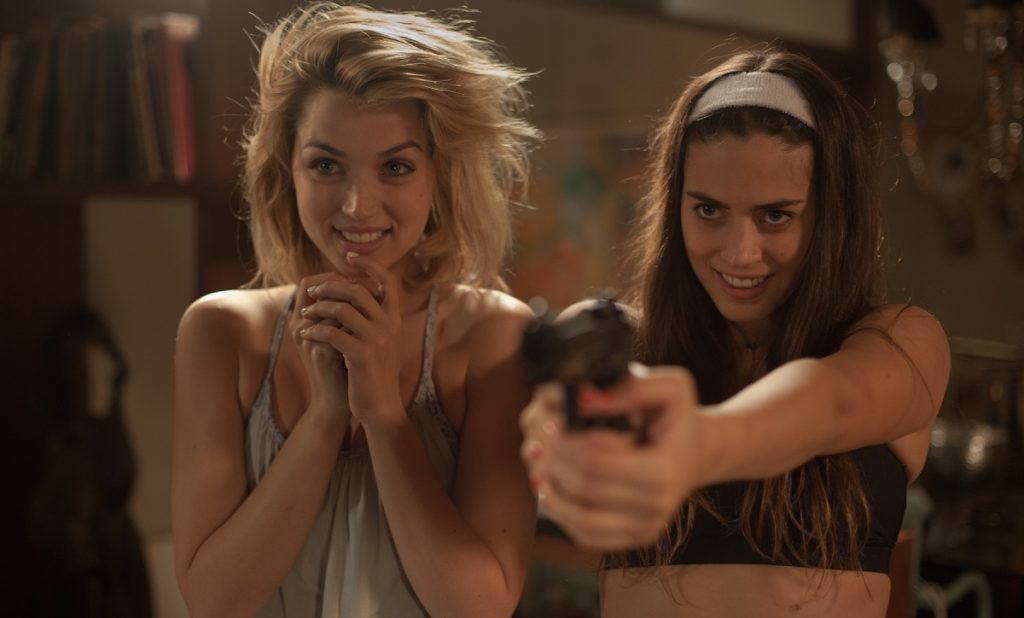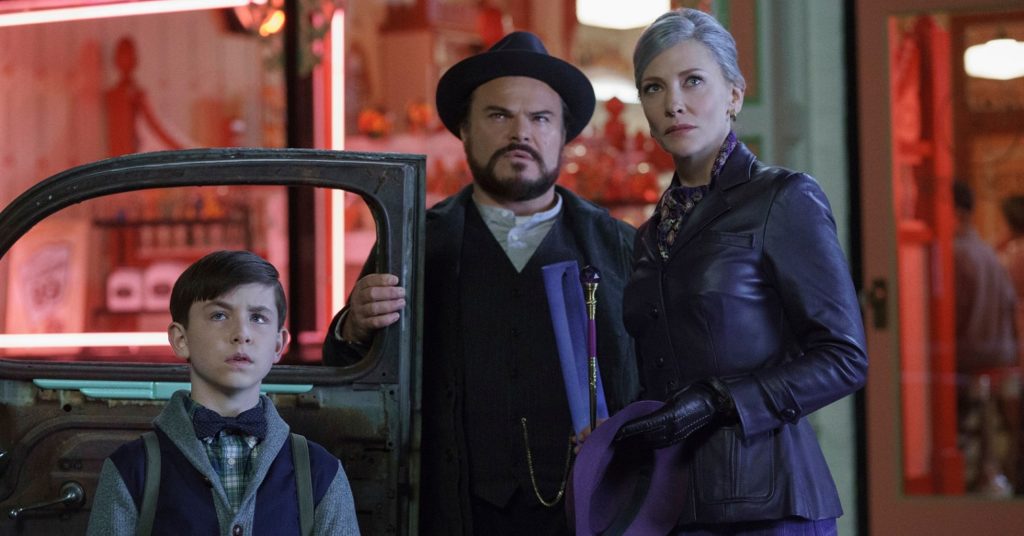Eli Roth has long thrived in a culture that does not seem to understand, nor like, him. This isn’t to say that he’s lacked success at the box office, nor that he doesn’t have a devoted, cult-ish fanbase; but rather, Roth’s work is consistently read in bad faith by critics and audiences alike. There has been a tendency in place to underestimate Roth from the get-go — when his most widely celebrated films (Cabin Fever and Hostel) were excoriated by a cowardly media class for their ostensible contributions to the erosion of society’s moral fortitude. These films became key texts in the genre dubbed “torture porn,” which was less a codified movement and more of a straw man — dissent cobbled together from the leftover pieces of the kind of Clinton-era propaganda that was wielded against Marilyn Manson and Beavis and Butthead. The idea was to blame artists for the increasingly unsettling displays of violence and existential dread that had a tight grip on the public psyche of that time, with the irony being, of course, that many of these films were created to address the very thing they were blamed for instigating. No director had a firmer grip on this than Roth, his 2000s work acting as a brutal, incisive critique on intersections of American evil. Cabin Fever and his two Hostel films are devious send-ups of entitlement and its symbiotic relationship with imperialism and pop culture. In hindsight, these films read as blatant satire, yet many refused to accept them as such; in many cases, they still won’t.
What makes Eli Roth such an essential voice in current American film culture is that he has only deepened and complicated his satire as the years have worn on. His first film of this decade didn’t arrive until 2015, eight years removed from its predecessor, Hostel II. And of course, the world changed dramatically in those intervening years, with social media becoming the dominant vehicle for modern communication that, in part, contributed to a sudden upswell of enthusiasm for social activism among American youth. Originally intended for a 2013 release (but hamstrung by its production company’s financial woes), 2015’s The Green Inferno is the Roth film from this decade that most resembles his work from the first half of his career — a strong transitional film that modernizes Hostel’s Ugly American critique for the age of Twitter-based activism. Roth (maybe) accidentally sabotaged the film’s chances at critical success throughout his press tour for the film, loudly proclaiming that The Green Inferno was his response to internet “slacktivists.” This is a bit of a mischaracterization of the film’s perspective, which seeks to criticize reckless, performative activism, but depicts a group of college activists who actually put their lives on the line for the cause. One could understand why this might be perceived as a misstep, but in reality, The Green Inferno represented a new boldness in Roth’s writing and direction, a rejection of what he may have perceived as a heavy handedness in his previous efforts — even if the majority of audiences wouldn’t agree. The film isn’t a blanket denunciation of activist efforts; instead, it’s an examination of the ways in which both college campuses and social media platforms are inherently insular systems that offer their users an unearned sense of worldliness. The Green Inferno’s protagonists are (with the exception of one) all relatively likable, their motivations for attempting to thwart the development of a Peruvian jungle perhaps not 100% selfless, but certainly not malicious either. The conflict that Roth focuses on here is, yes, one between cannibal natives and the student activists who are trying to protect them, but more specifically, the film is about the clash between those students and the newly complicated power structures (capitalism, state, media) that they aren’t prepared to contend with. The true horror of the film (besides the very graphic practical gore effects) comes as a realization that American interventionism will always be American interventionism.

In the two-year period between The Green Inferno’s completion and its release, Roth was able to put together his follow up, wrapping in time to also release it in 2015. Knock Knock is arguably Roth’s best and most complete film, and much like The Green Inferno, it saw him expanding on previously explored thematic territory while also being willfully misinterpreted by the critical community. Roth’s filmography is rich with depictions of horrible men, ranging from brutally violent psychopaths to overtly misogynist frat boys. As such, Knock Knock almost feels like a challenge, a conscious choice to move away from obviously grotesque displays of masculinity to a more coded version. Keanu Reeves plays Evan, the patriarch of a family that embodies the modern middle-class dream (two children, a dog, architect dad, sculptor mom), and who is lead to temptation by Genesis (Lorenza Izzo) and Bel (Ana de Armas) — two much younger women who show up at Evan’s home the very same night that the rest of his family goes on vacation. The two women act as a particular device for Roth, peeling back the layers of this family man and exposing his hypocrisy. There is a sense, as with many Roth characters, of performativity, of the fulfillment of a role that Reeves’s Evan feels some obligation towards, despite not truly believing in. While Evan presents himself as a very modern, mostly sweet patriarchal figure, Roth and his two leading ladies posit that there isn’t such a huge gulf between Evan and his 1950s analog. Sure enough, the family man submits to the two intruders’ seduction, soberly and without any real coercion, and spends the rest of the film desperately trying to preserve his ‘good guy’ image. Many assumed Roth to favor Evan’s perspective, and wrote the film off as misogynist — but once more, this is to read depiction, by default, as endorsement. Knock Knock indulges less in the explicit action of previous Roth pictures, and relocates that energy to dialogue and performance (the speed with which the goofy dad morphs into a guy ably slinging gendered slurs at his assailants is telling). While Evan ends up being faced with threats of physical harm, much of the film’s conflict is located in the character’s attempts to wrest back control of his life’s narrative. He is not regretful for his actions, but rather he’s regretful that he liked the attention he received from two women. Thus, the script presents Evan with the ultimate punishment: videos of his indiscretions posted on Facebook, videos that he accidentally “likes” when attempting to delete them. Which is to say that Roth concocts a new horror particular to a world of social media — the horror that people will learn who you really are.
What makes Eli Roth such an essential voice in current American film culture is that he has only deepened and complicated his satire as the years have worn on.
While The Green Inferno and Knock Knock saw Roth grow as an artist, and as a thinker, they also saw a major decline in his box office take, which perhaps explains his recent pivot into more studio-ready, gun-for-hire fare. This transition hasn’t been purely cynical, but instead a way of securing funding that he wasn’t receiving on his smaller projects, while at the same time offering the filmmaker the opportunity to work on a bigger scale than he ever has before. And in going down this road, Roth hasn’t had to mitigate his sensibility; his 2018 remake, Death Wish, is a major testament to this. The film shares some of Knock Knock’s sensibilities: its depiction of a seemingly good intentioned patriarch looking for a way to justify the unleashing of his id. The difference between these two comes, in part, from the respective cultural moments to which the productions are tethered. In Death Wish, Bruce Willis’s Paul Kersey is a dull, lackluster man who becomes radicalized on YouTube, and who uses the murder of his wife as an excuse to exact vigilante justice on random criminals. Death Wish is, in fact, quite an achievement for Roth, showing him capable of bringing his authorial voice to material that he did not write, and able to mold it into something that fits in with his thematic interests. It is a progression away from characters who are punished for the way they blithely abuse their privilege, and into new territory: Paul becomes more attuned to the power of his identity and station, as he does, he becomes more deft at weaponizing it.

Roth has charted a much more linear artistic progression for himself than many will give him credit, but when one approaches his filmography chronologically, there is a clear conversation happening between each film that gets more nuanced with each entry. While Death Wish is obviously in keeping with this auteurist approach, his other 2018 release sort of confounds the narrative thus far. The House With a Clock in its Walls stands out as a dramatic pivot toward family entertainment — and for having a broader sense of humor than any previous Roth film. It’s notable, as well, for receiving a cosign from Steven Spielberg’s Amblin Entertainment, who produced the film. And while it may have less of Roth’s previous work in its DNA, what he isn’t able to contribute in subtext or critique, he compensates for in visual ambition, making full use of his blockbuster budget. The House With a Clock in its Walls also affords Roth the rare chance to break away from the ugly, caustic perspectives of his past protagonists and underline what his work has always been about: pushing back on the nihilistic, violent forces that increasingly hold sway over the world.


Comments are closed.